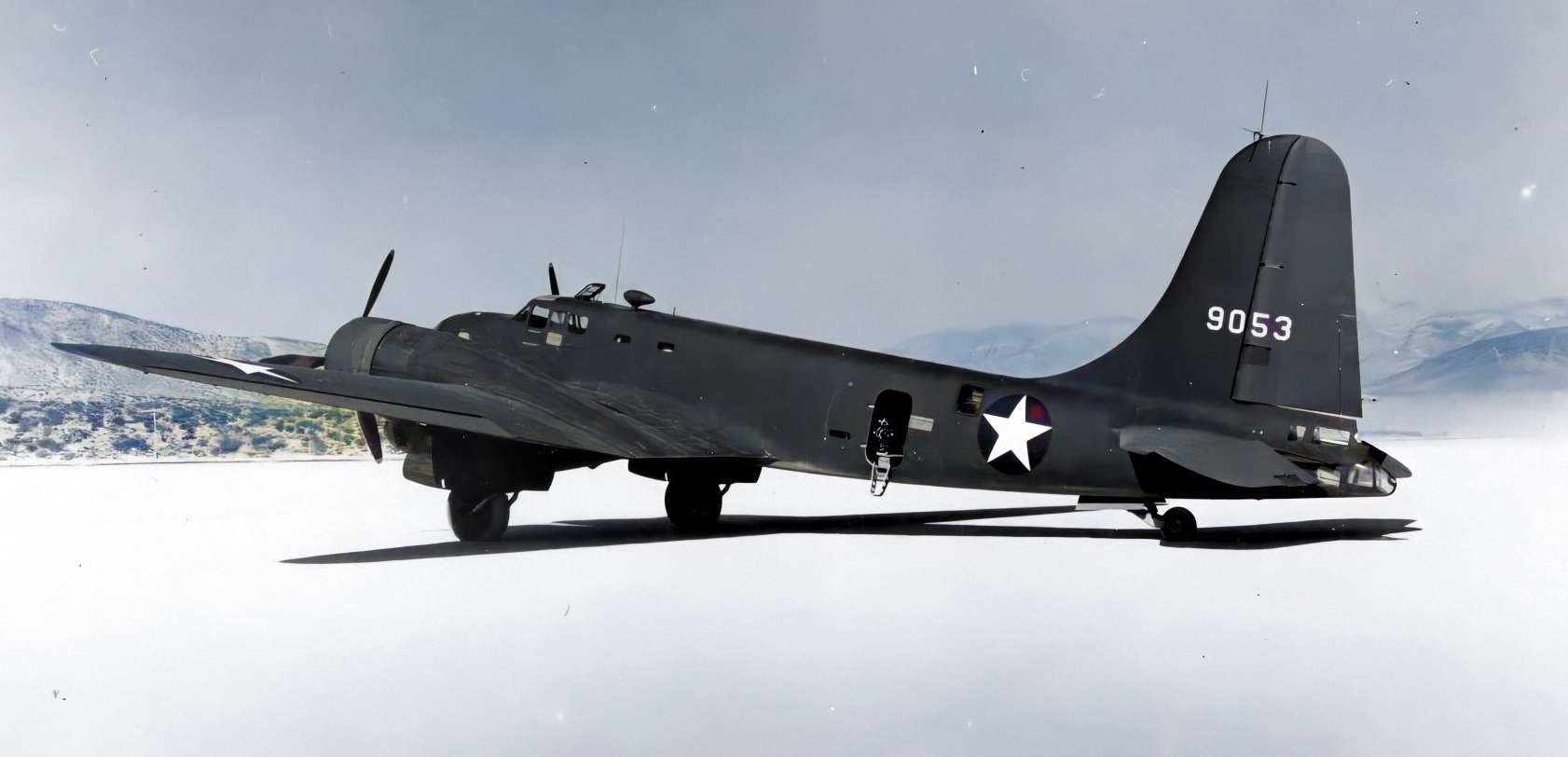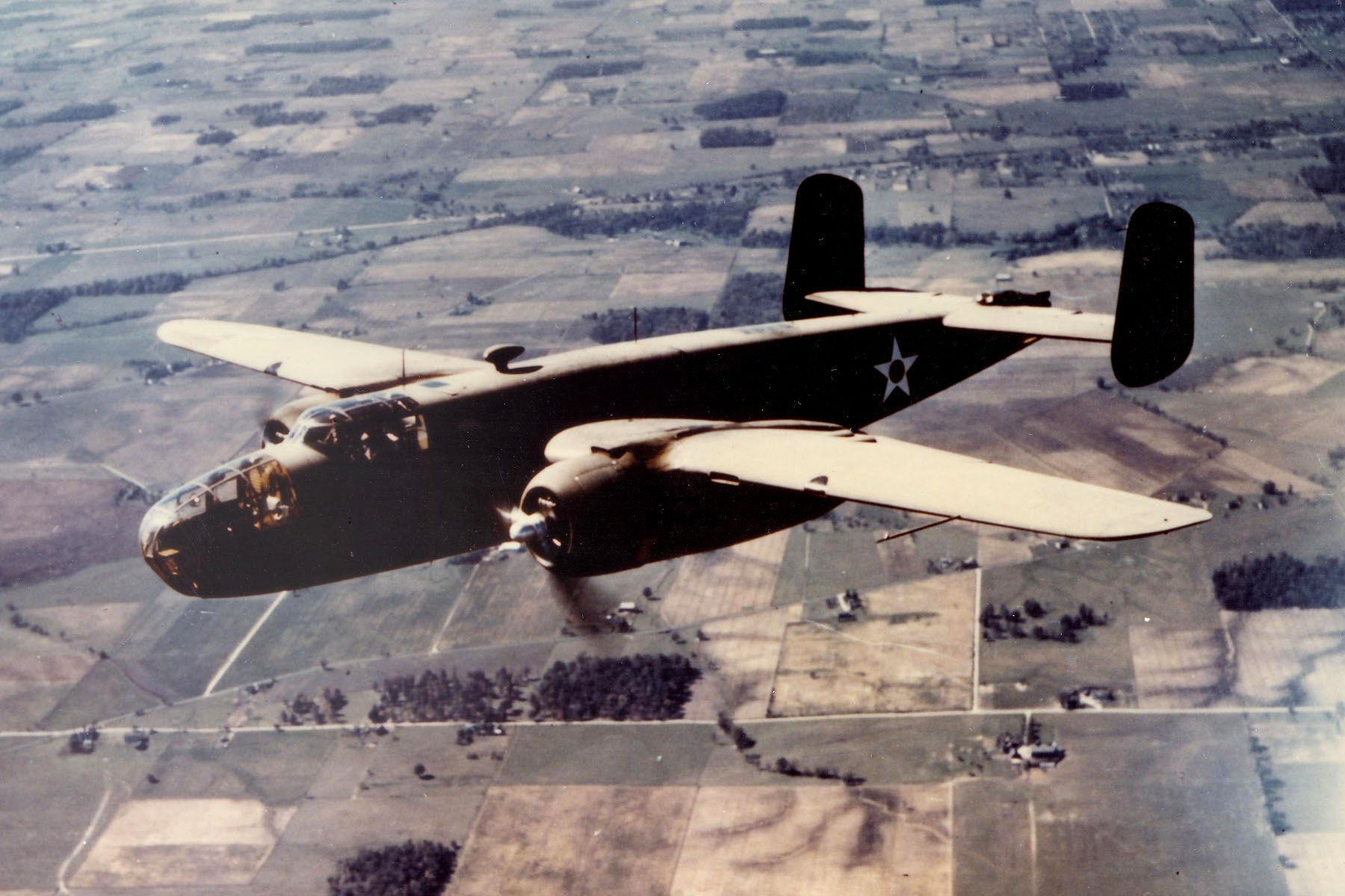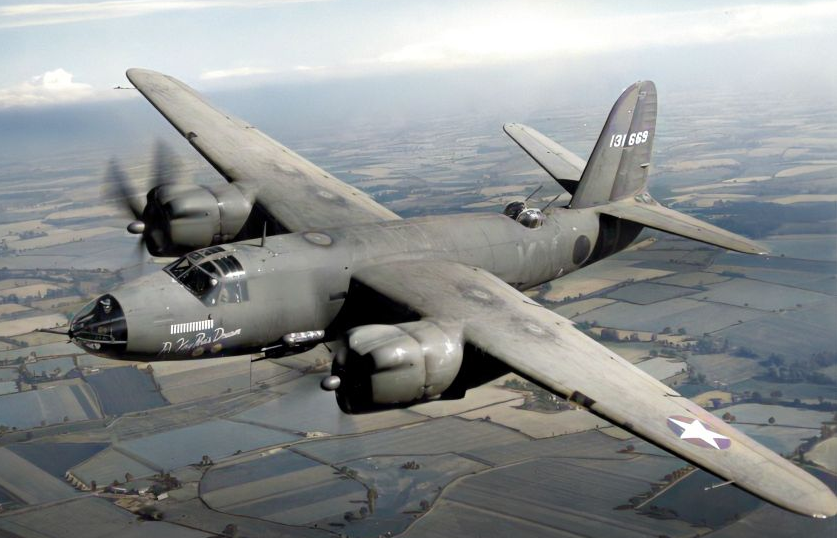The Doolittle Raid: Preparation and Training
Faced with the daunting task of taking off from a Navy carrier with larger Army bombers, Lt. Col. James Doolittle would select the North American B-25 “Mitchell” for the job, along with crews of volunteer pilots
USS Arizona burns at Pearl Harbor
On 7 December, 1941 the United States was thrust into the Second World War when the Imperial Japanese Navy launched a carrier based air attack on Pearl Harbor in Hawaii, the main anchorage of the US Pacific Fleet. This attack resulted in the destruction of most of the American battlefleet, crippling the ability of the US Navy to respond to the simultaneous Japanese attacks on American possessions across the Pacific. Guam, Wake Island and the Philippines had fallen, as had the British possessions in Hong Kong, Singapore and Malaya. The Rising Sun was flying high, and the American people were in desperate need of something to bolster sagging morale.
Japanese troops stand guard over Americans captured at Bataan during the infamous Death March
Bombing Tokyo had been a goal of many US leaders since Pearl Harbor, including President Roosevelt himself. As American officers weighed options, various other ideas were floated, with a even a proposal to entice the Soviets to launch the strike considered, although Stalin rejected the proposal. The idea that would eventually come to fruition, however, came from a submarine commander, Captain Francis Low.
Devastator torpedo bombers at NAS Norfolk
US Navy
In January of 1942 Low was taking off from the Naval Air Station at Norfolk, Virginia, and he noted the lines painted on the runway to simulate a carrier for training pilots for takeoffs from such a ship, and as he observed, Army medium bombers came in low over the area in a simulated attack, giving birth to the idea of launching such an aircraft from one of the Navy’s carriers.
Low flew back to the Washington Navy Yard, where he met with Naval Chief of Staff Admiral Ernest King, on whose staff Low was serving at the time. Aboard the USS Dauntless, the converted yacht used as quarters for the high ranking officers, he met with King, explaining his idea. King was receptive, and informed him to speak with Captain Donald Duncan, air officer on the staff, regarding the concept.
The USS Hornet under construction at Newport News Shipyards
The next problem was that even if the Army bombers could take off from a carrier, their landing would be out of the question. The possibility of having them ditch alongside the fleet, with the crews being picked up, was floated, but there was also a possibility of them flying onward to Free China or perhaps even the USSR. Aside from this, the questions of what actual aircraft type would be used, what carrier be tasked, which targets to be hit and a plethora of other quandaries.
Lt. Col. Jimmy Doolittle before the war
Meanwhile, the chief of the US Army Air Force, General Henry “Hap” Arnold was brought on board as well, and gave his approval for the mission. Indeed, he had already been toying with a similar idea of using Army bombers launched from carriers to support the planned American landings in North Africa. Arnold would tap one of the best pilots in the Army Air Force to plan the mission and lead the requisite training program, Lt. Col. James Doolittle.
Jimmy Doolittle had enlisted for the Great War, but had not seen any combat during the conflict. Not just a gifted pilot, he was also a graduate of MIT with a doctorate in aeronautical engineering, and he had spent the interwar period working as a stunt pilot, using his knowledge to push his aircraft to the limits of their design. He had also pioneered instrument (blind) flying, and worked with Shell to create 100 octane aviation fuel.
He had returned to active service in 1940, and had been busy working on improving the AAF’s all weather flight capabilities and supervising the conversion of civilian factories to military aircraft production. he had since been working on Arnold’s staff, and it was he who the Chief of Staff summoned to begin planning for the coming mission to Japan.



Three aircraft were considered by both the Navy and the Army for the operation: The Douglas B-23 Dragon, the North American B-25 Mitchell and the Martin B-26 Marauder.
B-23 Dragon
The Douglas B-23 Dragon was an improved version of the older B-18 Bolo medium bomber, but was still lackluster in its performance. The design had essentially reached its limit, and in addition, although the aircraft could take off within 500 feet, its huge ninety foot wingspan prevented its launch from a carrier, which could allow a maximum width of 75 feet. Thus the Dragon was rejected.
B-26 Marauder
The Martin B-26 Marauder was a relatively new, high performance aircraft which had almost been cancelled from production due to the difficulty in flying it, and indeed was commonly known as the “Murderer” due to its alarmingly high crash rate. Doolittle had overseen an improved training program for the aircraft, and it had proven to be capable, but it was not able to takeoff within the 500 geet limit with a bombload, leading to its rejection.
B-25 Mitchell
North American’s B-25 had a wingspan of 67 feet, and was capable of taking off within the required distance. In addition, it was a fairly forgiving aircraft to fly, meaning decreased training times and increasing the odds of success on such a dangerous mission. It was this aircraft that was selected, and as a result Doolittle set about acquiring the needed aircraft.
A B-25B at the Mid-Continent Modification Center in Minneapolis
Image courtesy B-25History.org
The only unit that was fully operational with the B-25 was the 17th Bombardment Group, and it was from this unit that both aircraft and (hopefully) volunteer crews would be sourced. The aircraft would first need to be modified, however, with increased fuel capacity and other alterations to increase range.
The first of these were completed at the Mid-Continent Airlines Modification Center; a civilian operation at the Minneapolis-St. Paul Airport in Minnesota. There 24 B-25Bs were fitted with addition fuel tanks, which increased the total capacity to 1,141 gallons, with tanks installed in the bomb bay, and another in place of the belly turret, which was removed both due to its weight and poor reliability. Another, collapsible tank was installed in the crawlspace over the bomb bay, which would prevent the movement of the crew between compartments until it was sufficiently emptied. Gas cans were also carried in the rear of the fuselage, where the gunner was to use them to manually top off the belly tank during flight.
A sentry patrols past a B25 at the Minneapolis modification center
Tom Norrbohm image via B-25History.org
Modifications also had to be performed on the bomb release equipment due to the placement of the bomb bay tank, and deicing equipment was installed for use in the event the planes flew to Russia for use as lend-lease aircraft. Due to a need for radio silence, the aircraft were stripped of radio equipment, also serving to reduce weight. Finally, the aircraft were now left with twin .50 caliber machine guns in the dorsal turret, as well as a single .30 caliber machine gun in the nose. In order to bluff possible Japanese interceptors, broomsticks were fitted to the tail as mock guns.
A B-25 in flight over the United States
USAF Photo, Original Color
As the modifications to the aircraft continued, the next step was to gather and train the men to crew them. The men of the 17th Bombardment Group had been bust testing the new B-25 in Washington and on cross country flights, and had taken part in the massive Louisiana Maneuvers in the fall of 1941. By early 1941, with the United States now at war, the Group had been ordered to South Carolina to interdict German U-boats operating off the coast, although some were sent to Minneapolis for additional work on their planes. After this was concluded, a meeting was held in a local hotel, where they were asked to volunteer for a special mission, with no details provided. Every man stepped forward. A similar scene took place with Doolittle himself the following day at the 17th Group base in South Carolina, and again, every man stepped forward.
A B-25 takes off from Eglin Field during training for the raid
USAF Photo
On 1 March, 1942 140 men crammed themselves into the operations center at Eglin Field in Florida, the men required to crew Doolittle’s 24 B-25s. Only the best of the volunteers had been sent here, as many more had accepted than were actually needed for the planned operation. Many of them would meet Doolittle for the first time on this day, as he entered to inform them that any of them could back out if they wished, and to emphasize the need to secrecy.
Navy Lieutenant Hank Miller was sent from Pensacola to instruct Doolittle’s men in carrier takeoffs, and upon arrival was unable to find Doolittle or his deputy, Major John Hilger, instead chatting with a group of pilots. Upon discovering that the Navy pilot had never even seen a B-25, let alone flown one, and they took him on a flight before he began instructions on low speed, short takeoffs. An informal competition quickly developed between the pilots to see who could take off in the shortest distance, using a runway with lines designating the length and width of a carrier deck.
Training also focused on low level, high speed bombing, with the aircraft flying so low as to require evasive action for trees at times, much to the chagrin of the local civilians. Another item discovered during this stage was that the famous Norden Bombsight was less than ideal for low level attack, and as a result a very simple sight, dubbed the Mark Twain, was designed by one of the pilots, Captain Ross Greening, and installed in the aircraft. The crude sight proved very effective as well as simple to use.
A view inside the nose of B-25 on dispay at the National Museum of the US Air Force, with the Mark Twain sight visible (the gray contraption beneath the instruments)
USAF Photo
Training continued, despite bad weather grounding the planes on several days, until late March, when the crews took their planes on a long distance flight at low level over the Gulf of Mexico, an event cited by Captain Ted Lawson as the “final exam” for the crews at Eglin. With the training nearing its conclusion, Admiral King decided it was time to go to Pearl Harbor, where he would personally brief Admirals Nimitz and Halsey on the plan. Doolittle flew up from Eglin Field to Washington on 15 March to meet with Duncan and Arnold, where he received the Navy’s full plan for their fleet movements in the operation. It was during this meeting that Doolittle asked Arnold for permission to personally lead the mission, and received a statement that if “Miff” (General Millard Harmon, Arnold’s Chief of Staff) consented, Doolittle could lead the raid. Doolittle was suspicious of this, and took off running down the hall, receiving permission from a bemused Harmon just before the phone rang with Arnold telling him to deny the request. By that time Doolittle was already on his way out of the office.
USS Hornet shortly after completion
For the US Navy’s part in the operation, the newest carrier in the fleet, USS Hornet, was selected. Boasting an 800 foot flight deck and a complement of over two thousand, she was skippered by Captain Marc Mitscher, a veteran Navy aviator. At the start of February, 1942, Captain Duncan had come aboard with two B-25s, who performed a successful test launch in poor weather. Subsequently, orders came down for Hornet to move through the Panama Canal and sail to the Navy base at San Diego, California. The officers and crew of the carrier remained unaware of the planned mission or the reason for the Army planes being launched from their deck, but it was obvious that soon the new ship would join the war.
USS Thresher
Other preparations were in motion as well. USS Thresher, a Tambor Class submarine of the Pacific Fleet, had been dispatched to the waters off the coast of Japan to patrol the area near the planned launch point, observing weather and sea conditions. As the submarine patrolled, the Hornet made several small cruises off the California coast, as aircrews for other carriers used her to practice takeoff and landing procedures.
On 19 March, 1942 Duncan arrived in Hawaii to meet with Nimitz and Halsey, who accepted the mission. Halsey was sent to San Francisco, and it was decided that the time had come for Doolittle’s pilots to take off and head for California and the Hornet. The pre-prepared code phrase was sent to Washington to inform them the Navy was ready:











